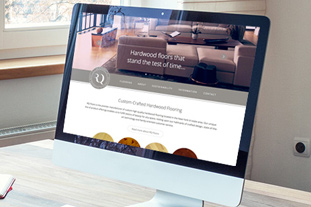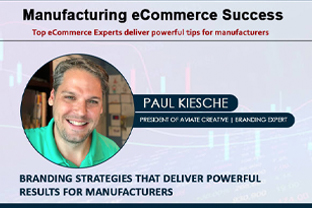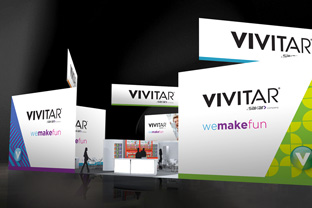Recently, Aviate President Paul Kiesche was a guest on an episode of the Manufacturing Ecommerce Success Series with Curt Anderson and Damon Pistulka. During this live Linkedin webinar, Kiesche covered various branding strategies for manufacturers and explained how branding plays a crucial role in solving manufacturers’ common challenges, many of which are unique to manufacturing and different from other industries.
You Can’t Be Everything to Everybody
Before rebranding to become a manufacturing branding agency, Kiesche shared that the original name of his business was Paul Kiesche Design. Initially, Kiesche targeted many different industries and was considered a generalist in the graphic design field. After feeling stuck and trying to make his services suit everyone, Kiesche realized two things: 1) A large percentage of his portfolio consisted of manufacturing and technology companies, and 2) He enjoyed working with them. This was when Kiesche decided to niche down and focus almost exclusively on manufacturing and technology.
After rebranding his own business to become an industrial branding agency, Kiesche saw firsthand the value of specializing. Realizing that you can’t be everything to everybody is something that often comes up in our conversations with manufacturers. Many of them sell commodity products and therefore, struggle to differentiate themselves. During our rebranding process, we help companies determine exactly what they do and who they serve. Many times, their outdated brands are a poor representation of their target audience. There’s a wide gap of time between who the audience was when the company first started and who the audience is today. When manufacturers can recognize the patterns and really identify their “sweet spot,” this will make the rebrand that much smoother and successful.
“I’m Not Having a Problem With Sales. So I Don’t Need to Rebrand, Right?”
Wrong. This is a common misconception about rebranding. Many times, manufacturers tell us that they don’t see the value in rebranding because they don’t need more sales. By associating their brands with sales and only sales, manufacturers are missing a valuable opportunity to benefit much more than their bottom lines.
Some of the most common challenges among manufacturers include employee recruitment/retention and profiting well with a commodity product. The good news is that a successful rebrand can significantly alleviate both of these problems. Perhaps you’re getting enough business and don’t need a brand that “wows” prospective customers, but what about prospective employees? Your brand defines how everyone will perceive your company, including talented industrial workers, investors, etc. It’s important for manufacturers to recognize that their brand is about much more than generating sales. It’s about communicating the value of the business to overcome challenges, whether they pertain to recruitment, pricing, growth, etc.
Rebranding Is a Key Part of the Exit Strategy
Regardless of industry, the ultimate goal of starting a business is to eventually sell it. Pistulka, who has spent years helping manufacturers sell their businesses, discussed the role that branding plays in the sale. Many times, prospective buyers will raise concerns over a brand that appears outdated. These buyers also know that they won’t necessarily inherit the longstanding relationships that allowed the business to survive with an outdated brand.
When selling a business, rebranding is often a crucial step in the exit strategy. Not only does it raise the value of the company, it also gives the owners more control over the business before handing it over to the investment company. Selling a business with an outdated brand only increases the chances that the investment company will completely change the look and feel of a company that the owners spent decades building. Rebranding before the sale allows owners to retain key characteristics of the company such as brand colors, brand signifiers and more.
Building a sellable business was a major reason why Kiesche went from Paul Kiesche Design to Aviate Creative. Attaching his own name to the company would deter potential buyers and it was already causing other problems. The name gave the impression that Kiesche was a one-man show when he actually had an in-house team. During the rebrand process, he advises manufacturers to build a brand for the future rather than the present: “You really want to make sure your brand creates the right perception and vibe for where you want to be. Not where you are now, but where you want to be within the next several years.”
How the Rebranding Process Is Tailored to Your Specific Goals
“Rebranding” is one word that represents a very extensive process. During the webinar, Kiesche delved into his process and explained how much work goes into each logo. Over the course of several conversations, Kiesche and his team explore the company from every angle, obtaining key information such as the company’s core values, target audience, short-term and long-term goals, etc. Many times, manufacturers don’t know how to answer these questions because they’ve never had to take such an introspective look at their company. After gathering all of the information and understanding the company’s unique challenges, the sketching phase can produce anything from 30-50 logo iterations. It’s a very detailed process, but an essential one that’s designed to ensure the final logo will effectively solve the company’s specific challenges. Whether the company wants to raise the prices of their products with less pushback from customers or recruit top talent, all of these factors are going to impact the look and feel of the logo.
Kiesche also emphasized that in order to stand out among the thousands of other manufacturers, companies need to create a strong first impression that can be communicated in seconds: “That logo is the first impression of your company and most people don’t go beyond first impressions. They’ll take a look for 2-3 seconds and if you’re not fitting the bill, they move on. So that logo is your big chance to say who you are, what you do and why you’re valuable. The logo creates perception and tells people what to expect with your company, from your in-house capabilities to your team.”
Outdated Brands Feed Outdated Perceptions About Manufacturing
When people think of manufacturing, many still picture dirty, run-down factories and less-than-desirable working conditions. While everyone within the industry knows how progressive and technology-focused the industry actually is, this doesn’t mean the younger generations do. Having walked through many manufacturing facilities, Kiesche remarked that, “More often than not, when you walk into a manufacturing facility, it’s like walking into the future. The environment is fresh and sterile and you’re surrounded by robotics. The perception is that manufacturing facilities still look the way they did 100 years ago, and that couldn’t be further from the truth. There needs to be a change of perception and education of that.”
In order to appeal to the younger generations, manufacturers need to create brands that look as cutting-edge as their businesses. This is something that technology companies do exceptionally well, while manufacturers lag behind. Even though manufacturers utilize technology just as much, if not moreso than a software or telecommunications company, there’s a disconnect between the brand and the reality.
Manufacturers need to replace their outdated brands and solidify their messaging if they want to attract the younger workforce. Once the logo is created, manufacturers’ in-house marketing teams should evaluate and update the messaging to ensure it matches the fresh new look. Manufacturers can also enlist the help of industrial copywriters who can take the company’s core values and differentiators and create an impactful brand story.
Prospective employees are looking at everything from your branding and your website to your Facebook page and Glassdoor profiles. They want to see how your company is involved in the community and what kind of events you hold outside of work. Even though manufacturers offer just as much as the technology companies, they aren’t communicating this through their website and branding. There are, however, a handful of manufacturers who are catching up, as we covered in this previous post.
When Rebranding, Think Beyond Your Industry
For manufacturers who are looking to grow and build a successful business, Kiesche reiterated the importance of branding for the future. If you initially named the business after yourself, it’s important to acknowledge the shelf life of your brand. Even if you plan on handing the reins over to family, the name still means little to your customers and your employees, both of whom will help determine the fate of your business.
Another way to brand for the future is to think beyond your industry and competition. Explore other industries for inspiration and try to set the bar instead of sticking to the status quo. For example, before transitioning to a manufacturing and industrial marketing agency, we worked with many law firms. During the rebranding process, we tried to think of each firm in a different context. If this law firm was a car company or a fashion company, what would they be? This way of thinking might seem unconventional—and it is. But it’s also what creates a unique look that stands out from the expected and overdone scales of justice imagery. Manufacturers, too, will need to decide whether they want to continue down the same road or embrace a brand that will actually solve their challenges and be so much more than a look.
Click here to listen to the full webinar and stay tuned for future events and tips!



